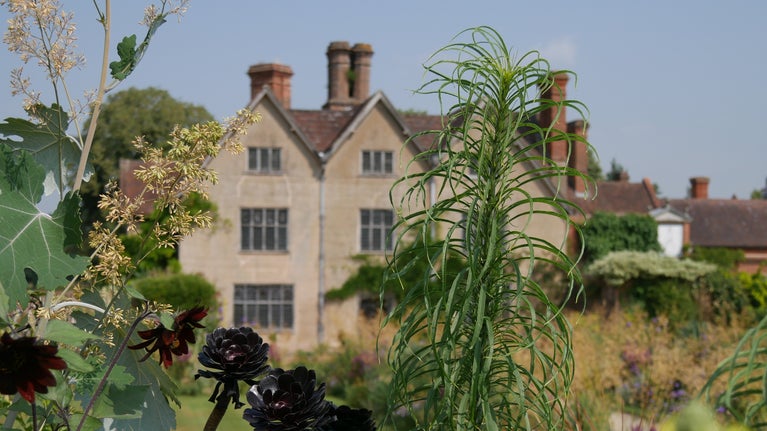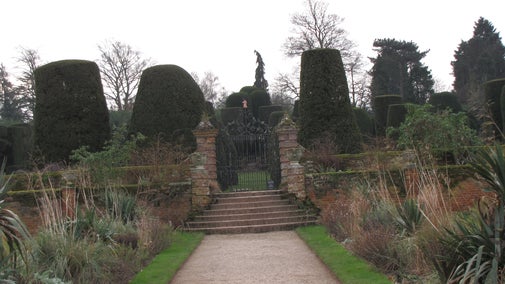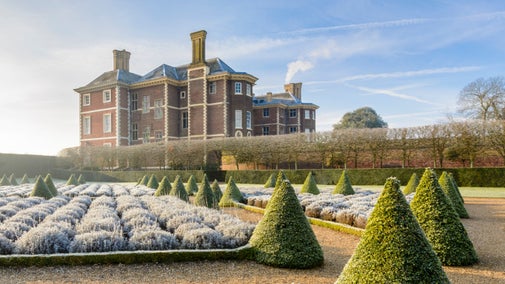
Discover more at Packwood House
Find out when Packwood House is open, how to get here, the things to see and do and more.

Explore the house at Packwood, where salvaged objects and exotic pieces come together in a Jacobean-meets-Edwardian style. During your visit, you'll wander through several meticulously furnished rooms, including the homely Drawing Room and the Great Hall, which was once a cow barn. The collection at Packwood House includes sixteenth century tapestries, technicolour stained-glass, and a teacup fit for a Queen.
For almost a century, two historic Midlands Tudor houses believed they were connected by fragments of the same 17th-century tapestry.
Now, that long-held assumption is being unravelled at Packwood House, where a new exhibition from 19 January – 5 April reveals the true and surprising story behind the fragments.
Common Threads will bring together Packwood House’s Two Women tapestry fragment and Selly Manor Museum’s Achilles fragment, displayed side by side at Packwood for the first time in living memory. While the two pieces were once thought to belong to a single, larger tapestry, a recent examination into the colour, imagery and weave has confirmed they are not connected.
The revelation came after a visit by the Packwood team to Selly Manor Museum in Bournville last year, prompting fresh investigation into both fragments and their histories.
Emily Greaves, Collections and House Manager at Packwood House, said: ‘The two tapestries, although they don’t match, have been a catalyst for a much larger story about the histories of our places. New links between our houses, people and collections have been revealed, leading to fresh and exciting narratives. Working in partnership with the team at Selly Manor Museum has been so enjoyable and following on from their exhibition last year the team are so excited to continue our work together for Packwood’s Common Threads exhibition in early 2026.’
This exhibition explores the wider significance of textiles as storytelling objects and the parallel histories of Packwood House and Selly Manor Museum. Both houses were shaped in the early 20th-century by passionate collectors: Graham Baron Ash at Packwood and Laurence Cadbury at Selly Manor. Both men were born in 1889 into Birmingham-based industrial families, served in WW1 as chauffeurs, travelled widely, collected with a passion and filled their homes with period furniture and objects.
The Common Threads exhibition at Packwood House, will be open from 19 January until 5 April 2026, Monday-Sunday 11am-3pm. Entry to the exhibition is included in admission.

The house at Packwood was first built around 1570 by the Fetherston family. Over the following 370 years, it was extended and restored to create the Tudor-style manor house you see today.
It was gifted to the National Trust in 1941 by Graham Baron Ash, a local man whose wealth enabled him to transform the house into his dream Tudor home in the early twentieth century. The rooms you can see today reflect his love of tradition, collecting, conserving and entertaining. Look out for the star items in each room.
There are two entrances for visitors to Packwood House: the 'Birmingham Door', so called because it was used by Baron Ash when he travelled to Birmingham, and the 'Leamington Door', for travelling to Leamington. You will enter through the Leamington Door, and a volunteer will welcome you before you go on to explore the Inner Hall, which was originally the entrance room in the Fetherston era.
The Drawing Room was created by adding a partition wall to make two separate rooms and was originally part of the Inner Hall. The fireplace is in the corner of the room because of this alteration. The room was likely used by Baron Ash for relaxing and entertaining.
Some of the collection items in the Drawing Room highlight one of Baron Ash’s proudest moments as owner of Packwood, Queen Mary's visit in 1927. The teacup, pen and chair she used while visiting are memorialised in this room, a lasting reminder of a very special visit.
The Dining Room was used for ‘posh’ dinners according to Baron Ash’s sister, Beryl, who also remarked how the room felt haunted. The six pieces of silver which sit on the two chests commemorate Baron Ash’s time as Sheriff of Warwickshire, a position he proudly held in 1938.
The Entrance Hall was extensively remodelled by Baron Ash, from an open galleried-staircase space to a more Tudor-style hall, with a magnificent double height window. An archive photograph on display shows how the room looked in 1921 before its renovations.
The Long Gallery is a deceiving space. From the inside it appears authentically Tudor, with its tapestry-adorned walls and beautiful wooden flooring. However, this space was built in the 1930s by Baron Ash to connect the Entrance Hall in the main house to the lone Great Hall. The tapestries in this room are just some of the 26 tapestries in the collection, and include the first one Baron Ash purchased, ‘Verdure with Two Chickens’, found in a cathedral in Tournai during his service in the First World War.
Once a cow barn, the Great Hall is the epitome of Baron Ash’s transformation of Packwood. He began restoring the space in the 1920s. A room used for entertaining guests, this is where Queen Mary took her tea in 1927 and where Prince George Chavchavadze gave a spinet recital in 1931. This spinet now sits in the Drawing Room. Dominating the room is a great seventeenth century oak table, bought by Baron Ash from Baddesley Clinton, a neighbouring National Trust property.
Take your time to wander around the house, the friendly volunteers are there to share the stories of Packwood with you.

Baron Ash named this room after the bed, which is said to have been slept in by Queen Margaret of Anjou, the wife of Henry VI, before the Battle of Tewkesbury in 1471 (when the bed was at Owlpen Manor in Gloucestershire). The Lookout Room next door was formerly the bathroom to Queen Margaret's bedroom next door. Baron Ash removed the fittings and took them to Wingfield Castle, where he moved to after leaving Packwood.
Queen Mary used this bedroom when she visited the house in 1927. Baron Ash was so thrilled at her visit, that a brass plaque was made and put up here.
Baron Ash converted this into a bathroom in the late 1920s - it is incredibly luxurious, with beautiful antique Delft tiles. All the other bathrooms in the house have these taps and lion's heads.
We hope you enjoy exploring the house here at Packwood, if you'd like to know more detail guidebooks can be purchased from the shop

There are many fascinating items to see at Packwood House. Alongside its famous tapestries, there is exquisite painted stained glass dating from the sixteenth century, a whole 1930s bathroom lined with old delft tiles, and much more.

Find out when Packwood House is open, how to get here, the things to see and do and more.
Delve into Packwood’s past and find out about how one man’s vision transformed a Georgian and Victorian style house into the perfect country house of Old England that we see today.

Find out more about what it takes to care for and conserve the collection and over 400 years of history at Packwood.

Explore Packwood’s garden and its seasonal delights. Flamboyant flower borders in a ‘mingled’ style, magnificent yew trees and a bountiful kitchen garden all wait to be discovered.

Find out more about volunteering at Packwood and how you can join the team and play your part in keeping Baron Ash’s vision of an English country estate alive.

From winding paths through woodland to wide open spaces, Packwood is the perfect place for a family day out in the great outdoors.

Historic houses and buildings are full of stories, art and collections. Learn more about their past and plan your next visit.

Discover the historic houses and buildings around Warwickshire, from secluded forest houses to grand rural retreats from the Tudor and Victorian eras.
